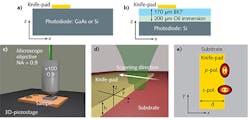Beam Profiling: Substrate materials influence knife-edge profiling of tightly focused beams
With myriad uses in nano-optics, plasmonic science, and microscopy, tightly focused laser beams can be analyzed using numerous beam-profiling methods. One classical option is knife-edge beam profiling, in which a very flat, razor-like knife blade is "sliced" through the tapering and waist section of a focused laser beam at different axial positions, building up a tomographic representation of the studied beam as the light intensity is recorded by a photodiode for that portion of the beam not blocked by the blade.
While it has long been known that the dimensions of the knife, the materials from which it is made, and the polarization and wavelength of the input laser beam can all influence the accuracy of the intensity data from which the beam profile is reconstructed, researchers from the Max Planck Institute for the Science of Light and the Friedrich-Alexander-University Erlangen-Nuremberg (both in Erlangen, Germany) have also experimentally determined that the substrate materials upon which the knife blades are fabricated can also impact the final beam profile result.1
Material interactions
Interaction of the light beam under study with the knife itself can distort and shift the positions of the measured intensity curves, and consequently the reconstructed beam projections. A dominant effect is the possible plasmonic excitation of metallic knife materials by the beam under test, for example.
The researchers devised a number of experiments using gold knife structures with heights of 130 and 70 nm, as well as a variety of substrate materials (see figure). A piezoelectric translation stage (with nanometer positioning accuracy) transports the knife structure on three different substrates through the beam: a substrate consisting of a gallium arsenide (GaAs) photodiode; a silicon (Si) photodiode (with a 120-nm-thick silicon dioxide protective layer); or a 170-μm-thick BK-7 cover glass over 200 μm of immersion oil placed on top of a Si photodiode. A linearly polarized Gaussian beam is focused onto the knife edge and substrate using a 0.9 numerical aperture objective lens.
The beam profile is scanned in two polarization directions along the major and minor axes of the focused beam spot. Measurements are also made at five different wavelengths between 535 and 700 nm to understand the wavelength dependence of the beam profile parameters.
Upon conclusion of the experiments, the data showed that the measured values of the reconstructed beam sizes were very different from each other for different substrate materials. Using simplified mathematical models, the researchers were able to deduce the reasons for these beam-profile variations with different substrates. Essentially, the plasmonic excitation of the knife-edge as well as transmission through it and reflection from its interfaces distort the profiles of the beam under test. All aforementioned effects depend on the polarization of the input beam, the chosen substrate material, and several other edge and beam parameters.
"With our study, we were able to reveal that beam profile information resulting from knife-edge-based reconstruction schemes sensitively depends on the material of the substrate used as a support for the knife blades. This parameter was not considered or taken into account so far," says Christian Huber, PhD student at the Max Planck Institute for the Science of Light. "In particular, our study also helps to understand the interactions of tightly focused light beams with sharp metal edges," he adds.
REFERENCE
1. C. Huber et al., Opt. Express, 24, 8, 8214–8227 (Apr. 18, 2016).

Gail Overton | Senior Editor (2004-2020)
Gail has more than 30 years of engineering, marketing, product management, and editorial experience in the photonics and optical communications industry. Before joining the staff at Laser Focus World in 2004, she held many product management and product marketing roles in the fiber-optics industry, most notably at Hughes (El Segundo, CA), GTE Labs (Waltham, MA), Corning (Corning, NY), Photon Kinetics (Beaverton, OR), and Newport Corporation (Irvine, CA). During her marketing career, Gail published articles in WDM Solutions and Sensors magazine and traveled internationally to conduct product and sales training. Gail received her BS degree in physics, with an emphasis in optics, from San Diego State University in San Diego, CA in May 1986.
